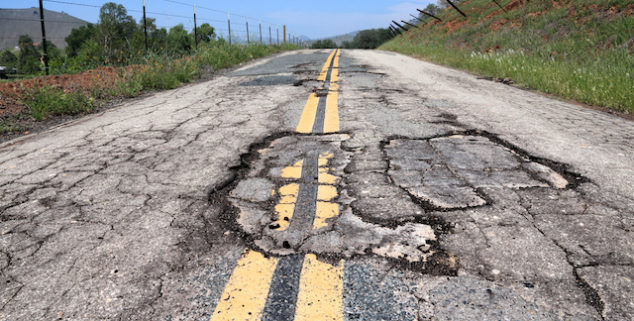News
California wants a hefty slice of that $2 trillion pie
 A damaged highway in a rural area of California. (Photo: Tupungato, via Shutterstock)
A damaged highway in a rural area of California. (Photo: Tupungato, via Shutterstock)What might President Biden’s colossal proposal to address the nation’s crumbling highways, bridges, transit systems and other critical infrastructure mean to California?
Admittedly, the $2 trillion fix is a long way from becoming reality. It’s still in the House, and Senate passage as the bill is written is a big “if.”
Republicans are expressing doubt, saying the plan is just too expensive. Biden, who has called his proposal “a once in a generation investment in America,” says he’s willing to talk about it, but hopes to get his plan approved by the summer.
California has approximately 12 percent of the nation’s population, so does that mean California would get 12 percent of the goodies?
Passage inched a bit closer to reality with an April 5 ruling from the Senate parliamentarian that in effect allowed Democrats to attempt getting Senate approval by avoiding a Republican filibuster.
The president envisions infrastructure improvements to be made over the next eight years, with financing from corporate tax hikes over the next 15 years. The business tax rate is now 21 percent; Biden wants to increase it to 28 percent.
Among many other things, the Biden proposal calls for:
–$115 billion to be spent on roads and bridges
–$80 billion on passenger and freight railways
–$25 billion on airports
–$20 billion on road safety improvements.
Using a rough back-of-the envelope formula specifying that California has approximately 12 percent of the nation’s population means that California, at least theoretically, would get perhaps 12 percent of the goodies, as the proposal is currently written. That translates roughly into:
–$13.8 billion on roads and bridges
–$9.6 billion on passenger and freight railways
—$3 billion on airports
–$2.4 billion on road safety improvements
Right now, the state spending plan provides $23.5 billion for transportation programs, including money for the Highway Patrol and the Department of Motor Vehicles.
Eunice Roh of the Legislative Analyst’s Office points out that it’s really not that simple.
“It’s hard to say it (the apportionment) will be solely on the basis of population,” she told Capitol Weekly in a telephone interview. “Inevitably it’s going to go through changes. Who knows what the result will be?”
Although Caltrans at this stage has yet to receive detailed figures associated with President Biden’s proposal, Caltrans Director Toks Omishakin is enthusiastic about the possibilities.
“President Biden’s landmark infrastructure proposal is in lockstep with California’s investment in transportation four years ago this month with the passage of SB 1,” Omishakin said in a statement.
“The state will benefit from this forward-thinking federal plan to fix our aging infrastructure, mitigate climate change by championing electric vehicles and making substantial investments in transit, address racism and issues of equity, and create millions of jobs in California and the nation,” Omishakin added.
Right now, the state spending plan provides $23.5 billion for transportation programs, including money for the Highway Patrol and the Department of Motor Vehicles.
In June of 2019, the American Society of Civil Engineers, which likes to see lots of work upgrading infrastructure, graded California on three categories:
- Roads: D
- Bridges: C-
- Transit: C-
More is involved in the Biden plan that pouring more concrete and pounding nails. The Deloitte consulting firm has declared that Biden wants to reinvigorate the federal role in state and local governments:
“From health care to the economy, from transportation to housing, the Biden campaign proposed a more robust federal role in the priorities and operations of state and local governments.”
Assemblywoman Laura Friedman, (D-Glendale) who chairs the Assembly Transportation Committee, applauds Biden’s “aggressive” attempt in the package to address climate change. As part of that, if the proposal becomes reality, Friedman would like to see more money invested in transit.
“I hope all the money is not strictly used for autos. That would be a mistake,” she told Capitol Weekly in a telephone interview.
Asked if Democrat Biden’s largesse would translate into a political boon for California Democrats, Democrat Friedman is cautious.
“I would hope that people would remember who made it all possible,” she said.
Want to see more stories like this? Sign up for The Roundup, the free daily newsletter about California politics from the editors of Capitol Weekly. Stay up to date on the news you need to know.
Sign up below, then look for a confirmation email in your inbox.

Leave a Reply